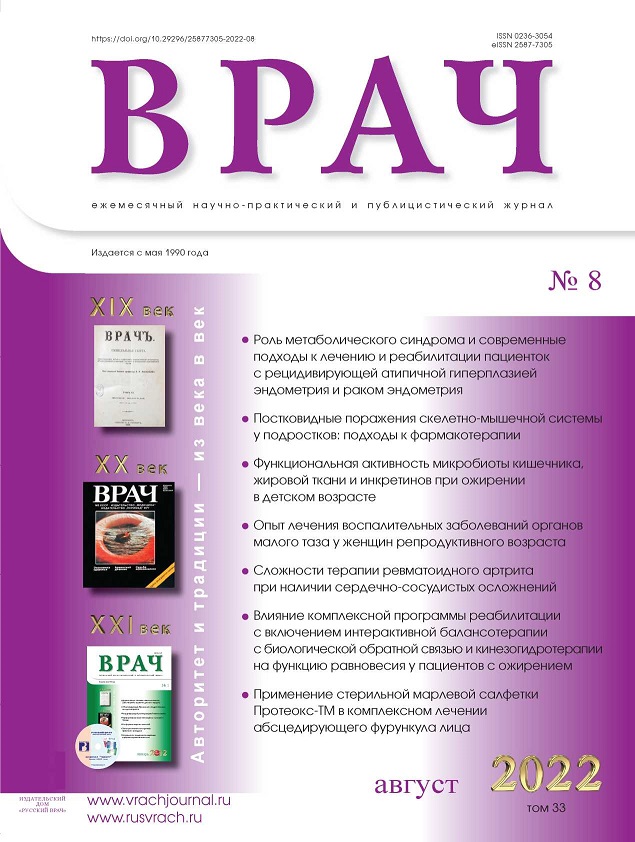Relationship between the type of body composition and the course of chronic erosive gastroduodenitis in children
- Authors: Kharitonov D.V.1,2, Sapozhnikov V.G.1,2, Osiptsov N.V.2, Nikishina Y.I.2
-
Affiliations:
- Tula State University
- Tula Children’s Regional Clinical Hospital
- Issue: Vol 33, No 8 (2022)
- Pages: 47-49
- Section: From Practice
- URL: https://journals.eco-vector.com/0236-3054/article/view/114669
- DOI: https://doi.org/10.29296/25877305-2022-08-09
- ID: 114669
Cite item
Abstract
The paper presents the results of a study of the relationship between the type of body composition and the course of chronic erosive gastroduodenitis (CEGD) in children. The study involved 54 patients (34 boys, 20 girls) aged 12 to 18 years with CEGD. The body composition type of a child was determined using the Pinier index according to the procedure designed by M.V. Chernorutsky. All the patients underwent esophagogastroduodenoscopy with biopsy material sampling, followed by histopathological examination, a breathing test for Helicobacter pylori (Hp), a serological test for Hp IgG and IgM, and an objective examination. Among the children with CEGD, asthenics (68.5%) prevailed; hypersthenics (18.5%) and normosthenics (13%) were less common.
Full Text
About the authors
D. V. Kharitonov
Tula State University; Tula Children’s Regional Clinical Hospital
Email: vladim1409@yandex.ru
V. G. Sapozhnikov
Tula State University; Tula Children’s Regional Clinical Hospital
Author for correspondence.
Email: vladim1409@yandex.ru
доктор медицинских наук, профессор
N. V. Osiptsov
Tula Children’s Regional Clinical Hospital
Email: vladim1409@yandex.ru
Yu. I. Nikishina
Tula Children’s Regional Clinical Hospital
Email: vladim1409@yandex.ru
References
- Мазурин А. В., Мирошниченко В. А., Борчунова Н. Н. и др. Первичные гастродуодениты у детей. Вопросы охраны материнства и детства. 1975; 1: 23-8.
- Сапожников В.Г. Эхографические критерии патологии органов гастродуоденальной зоны у детей. Дисс. д-ра мед. наук. Витебск, 1992; 371 с.
- Запруднов А.М. Гастродуоденит у детей (Патогенез, клиника, диагностика, лечение). Автореф. дисс. д-ра мед. наук. М., 1985; 31 с.
- Лечение и рациональная фармакотерапия заболеваний органов пищеварения у детей. Под ред. А.М. Запруднова. М.: Миклош, 2010; 320 с.
- Дронова О.Б., Третьяков А. А., Мищенко А.Н. и др. Клинико-эндоскопические и морфологические проявления гастроэзофагиальной рефлюксной болезни у детей. Экспериментальная и клиническая гастроэнтерология. 2018; 1: 56-60.
- Харитонова Л. А. Желчнокаменная болезнь у детей (особенности патогенеза, клиники, диагностики, лечения). Автореф. дисс. д-ра мед. наук. М., 1998; 52 с.
- Сапожников В.Г. Некоторые разделы детских болезней. Тула: Изд-во ТулГУ, 2021; с. 217-25.
- Никитюк Б.А., Козлов А.И. Новости спортивной и медицинской антрологии. М.: Спортинформ, 1990; вып. 3: 121-41.
- Николаев В.Г., Прохоренков В.И., Винник Ю.Ю. Оценка соматитипа как предрасполагающего фактора к развитию хронического простатита. Сб. мат-лов конф. «Биомедиц. и биосоц. пробл. интеграт. антропол». СПб, 1999; с. 237-40.
- Бунак В.В. Нормальные конституциональные типы в свете данных о корреляциях отдельных признаков. Ученые записки МГУ. Антропология. М.: Изд-во МГУ, 1940; с. 59.
- Воробьева A.B. Последние тенденции постановки диагноза острая пневмония у детей. Вестник новых медицинских технологий. Электронное издание. 2019; 1: 1-8. URL: http://www.medtsu.tula.ru/VNMT/Bulletin/E2019-1/1-8.pdf
Supplementary files









